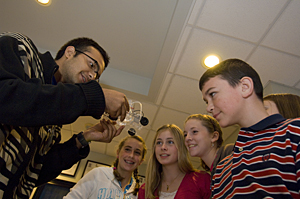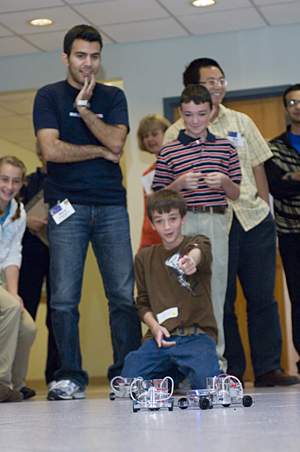
- Rozovsky wins prestigious NSF Early Career Award
- UD students meet alumni, experience 'closing bell' at NYSE
- Newark Police seek assistance in identifying suspects in robbery
- Rivlin says bipartisan budget action, stronger budget rules key to reversing debt
- Stink bugs shouldn't pose problem until late summer
- Gao to honor Placido Domingo in Washington performance
- Adopt-A-Highway project keeps Lewes road clean
- WVUD's Radiothon fundraiser runs April 1-10
- W.D. Snodgrass Symposium to honor Pulitzer winner
- New guide helps cancer patients manage symptoms
- UD in the News, March 25, 2011
- For the Record, March 25, 2011
- Public opinion expert discusses world views of U.S. in Global Agenda series
- Congressional delegation, dean laud Center for Community Research and Service program
- Center for Political Communication sets symposium on politics, entertainment
- Students work to raise funds, awareness of domestic violence
- Equestrian team wins regional championship in Western riding
- Markell, Harker stress importance of agriculture to Delaware's economy
- Carol A. Ammon MBA Case Competition winners announced
- Prof presents blood-clotting studies at Gordon Research Conference
- Sexual Assault Awareness Month events, programs announced
- Stay connected with Sea Grant, CEOE e-newsletter
- A message to UD regarding the tragedy in Japan
- More News >>
- March 31-May 14: REP stages Neil Simon's 'The Good Doctor'
- April 2: Newark plans annual 'wine and dine'
- April 5: Expert perspective on U.S. health care
- April 5: Comedian Ace Guillen to visit Scrounge
- April 6, May 4: School of Nursing sponsors research lecture series
- April 6-May 4: Confucius Institute presents Chinese Film Series on Wednesdays
- April 6: IPCC's Pachauri to discuss sustainable development in DENIN Dialogue Series
- April 7: 'WVUDstock' radiothon concert announced
- April 8: English Language Institute presents 'Arts in Translation'
- April 9: Green and Healthy Living Expo planned at The Bob
- April 9: Center for Political Communication to host Onion editor
- April 10: Alumni Easter Egg-stravaganza planned
- April 11: CDS session to focus on visual assistive technologies
- April 12: T.J. Stiles to speak at UDLA annual dinner
- April 15, 16: Annual UD push lawnmower tune-up scheduled
- April 15, 16: Master Players series presents iMusic 4, China Magpie
- April 15, 16: Delaware Symphony, UD chorus to perform Mahler work
- April 18: Former NFL Coach Bill Cowher featured in UD Speaks
- April 21-24: Sesame Street Live brings Elmo and friends to The Bob
- April 30: Save the date for Ag Day 2011 at UD
- April 30: Symposium to consider 'Frontiers at the Chemistry-Biology Interface'
- April 30-May 1: Relay for Life set at Delaware Field House
- May 4: Delaware Membrane Protein Symposium announced
- May 5: Northwestern University's Leon Keer to deliver Kerr lecture
- May 7: Women's volleyball team to host second annual Spring Fling
- Through May 3: SPPA announces speakers for 10th annual lecture series
- Through May 4: Global Agenda sees U.S. through others' eyes; World Bank president to speak
- Through May 4: 'Research on Race, Ethnicity, Culture' topic of series
- Through May 9: Black American Studies announces lecture series
- Through May 11: 'Challenges in Jewish Culture' lecture series announced
- Through May 11: Area Studies research featured in speaker series
- Through June 5: 'Andy Warhol: Behind the Camera' on view in Old College Gallery
- Through July 15: 'Bodyscapes' on view at Mechanical Hall Gallery
- More What's Happening >>
- UD calendar >>
- Middle States evaluation team on campus April 5
- Phipps named HR Liaison of the Quarter
- Senior wins iPad for participating in assessment study
- April 19: Procurement Services schedules information sessions
- UD Bookstore announces spring break hours
- HealthyU Wellness Program encourages employees to 'Step into Spring'
- April 8-29: Faculty roundtable series considers student engagement
- GRE is changing; learn more at April 15 info session
- April 30: UD Evening with Blue Rocks set for employees
- Morris Library to be open 24/7 during final exams
- More Campus FYI >>
3:40 p.m., Oct. 14, 2008----Richard Wool, UD professor of chemical engineering, may be finding valuable uses for chicken feathers in advanced composite materials, but on Saturday morning, Oct. 4, UD mascot YoUDee wasn't willing to sacrifice any of its tail feathers for the cause, much to the delight of the 200-plus talented youth and family members who attended a program on energy and the environment on campus.
Sponsored by the Johns Hopkins University Center for Talented Youth (CTY), the event was part of the Science & Technology Series offered through CTY's Family Academic Programs.
Despite the early morning clowning between the chemical engineering professor and the University mascot, the message of the day was serious. In welcoming the group of seventh- to tenth-graders, Provost Dan Rich said that we are living in one of the most transformative times in history, based not only on technology developments but also on access to information.
“A key ingredient in the 'flat world,'” Rich said, referring to Thomas Friedman's metaphor for the level playing field effected by globalization, “is creative imagination. The leaders of the future will be those that are the most creative and those that are the most imaginative, and you have the potential to be among those leaders.”
Rich referred to UD's long history of excellent and innovative work in energy and the environment and the interaction between them. “New technologies will transform the entire field of energy production,” Rich said. “It's not just one area but the confluence of knowledge from many different fields.”
Wool discussed his ongoing work on bio-based materials, which began several years ago with a John Deere tractor part made from soybeans. Since then, he and his colleagues have developed a printed circuit board made from chicken feathers and a hurricane-resistant roof made from recycled newspapers. The all-natural materials are used as reinforcement for resins made with plant oils.
“Those projects have been fun,” Wool said, “but now it's time to get serious.” He and his research team are currently looking at ways to use natural materials for hydrogen storage and wind turbine blades. “We need to take a multi-pronged approach to green energy,” he said.
Following Wool's keynote address, the students spent the remainder of the day in hands-on workshops on solar cells, biofuels and UD's vehicle-to-grid car project; wind turbine and fuel cell car competitions; a composites manufacturing simulation; and a “carbon footprint” activity.
Parents heard talks on a similar slate of subjects by University faculty, as well as presentations on preparing for selective college admissions by Admissions Director Louis Hirsh and Honors Program Director Alan Fox, professor of philosophy.
In addition to Rich and Wool, faculty participants included Suresh Advani, Josh Hertz and Ajay Prasad, mechanical engineering; Mark Barteau and Annette Shine, chemical engineering; Willett Kempton and Jeremy Firestone, marine and Earth studies; and Ismat Shah, materials science and engineering. In addition, a large contingent of graduate and undergraduate engineering students and Blue Hen Ambassadors assisted with workshops and tours.
The UD program was coordinated by Kathleen Werrell, assistant dean and coordinator of engineering outreach.
“We received many positive comments throughout the day from parents as well as students,” Werrell said. “As I chatted with students, they all seemed enthusiastic about the sessions in which they participated--for example, one young man couldn't wait to show his parents the penny that had been 'turned into' a dime through the 'sputtering process' in materials science.”
Article by Diane Kukich
Photos by Jon Cox



